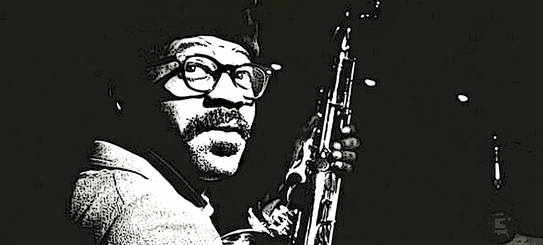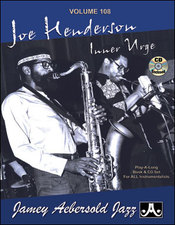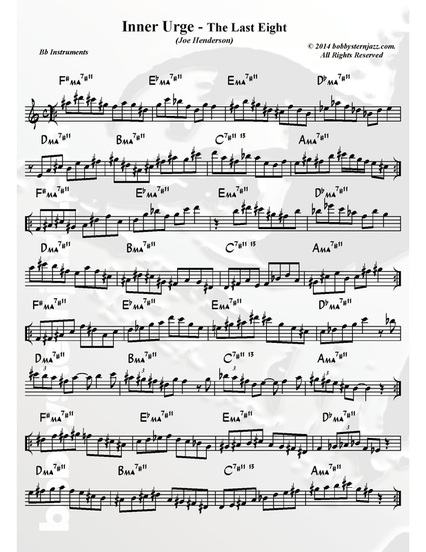Joe Henderson's "Inner Urge" - The Last Eight
 Smokin' Joseph
Smokin' Joseph Joe Henderson, as quiet as it's been kept, is not only one of the greatest tenor saxophonists of the musical genre we know and love as "Jazz", but one of it's most prolific composers, as well as one of it's truly unique and creative improvisational voices.

The elements of Henderson's playing that make him my personal favorite, for just plain listening
enjoyment are:
1) His dark, bitter-sweet chocolate (another favorite) tone, possibly due in part to the Selmer D mouthpiece (I believe) he used, which had a small tip opening.
A long time friend and mentor, trombonist/ pianist/ composer/ arranger Joe Gallardo (interview forthcoming), told me, that Henderson played right up on the microphone and was actually difficult to hear just a few feet away. This statement comes from Gallardo's experience as a fellow sideman on trumpeter Luis Gasca's "The Little Giant" sessions from 1968.
This would make sense, since the "harder" or "louder" one attempts to play a saxophone, the more upper partials (overtones) are created, thereby creating a "brighter" more "strident" tone. Henderson, a veteran of scores of recordings by that time, was certainly aware of this basic accoustic phenomenon, and worked the mic accordingly.
2) His harmonic approach. While it is beyond the scope of this post to delve completely into the vast waters of this subject, the downloadable pdf below contains exercises based on the last eight bars of Henderson's well known classic "Inner Urge", from his 1964 Blue Note album of the same name. These are not transcriptions of Joe's solo, rather some recent scibblings of my own, done as an aid to better internalize the uncommon chord progression of the tune's final eight measures.
The root movement of this section of the tune is symmetrical and goes (in tenor key):
F# - Eb - E - Db - D - B - C - A, each chord lasting one bar apiece.
In other words; down a minor 3rd - up a half step - down a minor 3rd - up a half step - down a minor 3rd - up a half step - down a minor 3rd.
This root movement could be viewed as 4 sets of minor thirds, descending in whole steps every other measure.
This descending minor third root movement was utilized in parts of several Joe Henderson originals of the period, namely "Isotope" (last 2 measures, diminished cycle) and "Tetragon" (second 4 bars, 2 complete diminished cycles, a P5th apart) come to mind. Both of these tunes are highly original blues, which is another thing I love about Joe Henderson, he was a great and original blues interpreter.
Getting back to the "Urge", the chord qualities are, except for the C7 #11 in the next to last bar, all Maj7#11s, which lend themselves to a number of pentatonic scale possibilities each. The #11, lydian quality is an optional choice. Choices for the first measure could include:
F# Maj penta (F#-G#-A#-C#-D#), G# Maj penta (G#-A#-C-D#-F), C# Maj penta (C#-D#-F-G#-A#).
The C7#11 chord in the seventh bar is pure genius, as it breaks up the flavor of the preceding changes, while keeping the symmetrical integrity of the root movement intact. A D penta b6 (D-E-F#-A-Bb), derived from G melodic minor, is the flavor ingredient here.
The exercise examples here are not Joe's licks or taken from his solos and they are not necessarily meant for "plug & play", rather; as a study of possible connections over this eight bar progression.
Here's a link to a home recording from a few years ago of "Inner Urge" (from which the below exercises are also not derived) which I did with an Aebersold play-a-long from Vol. 108 (great to practice with), where I'm attempting my best Joe impersonation.
It's almost impossible not to use some of his nuances, as 1) the kickass rhythm section, which includes Steve Allee - piano; Tyrone Wheeler - bass; and Steve Davis - drums, is doing a great job of "copping the feel" of the original; and 2) I've been listening to and absorbing the original recording for about 40 years.
Call it a "toot your own horn" moment.
A question arises: Did Joe play the way he did because of his composing style, or did he compose to accommodate his playing style? I would say, "both".
3) as to why I love Joe Henderson's playing can be summed up as his "intellectual, funky earthiness". Like 'Trane and Monk, he was a musical scientist with a deep "blues sensibility", a mark of his generation, and one that seems to be, sadly, disappearing from the music.
One more thing that has always struck me about Joe's playing, especially during his earlier Blue Note period, is his quickness of mind, which led to a seemingly endless stream of fresh ideas, rhythmic and melodic, devoid of cliches, even his own. If improvisation is spontaneous composition, then Joe Henderson was definitely among the most spontaneous.
So, I think it's about time Joe Henderson get his props as one of the all-time great contributors to improvised music.
Now folks, I leave you with this jewel, which I discovered late last night, while scanning the net for pics of Joe Henderson for this post.
It's a 117 page doctoral dissertation by Arthur Lynn White entitled:
Joe Henderson: An Analysis of Harmony in Selected Compositions and Improvisations. (2008)
This is a MUST READ by anyone interested in the man, in particular, or the music in general. It includes a section of biographical info as well as a full chapter analysis of "Inner Urge", section by section.
This is the most informative piece of writing I've seen on Joe Henderson, who still remains too much of a "mystery man" relative to his accomplishments.
| The Original. The Classic. | LIVE Recording from 1966 Horace Silver 5tet feat. Joe Henderson & a young Woody Shaw on Joe's tune, "Mo' Joe". Joe's solo is off the @#$%^ chain (Woody's, too)! |

 RSS Feed
RSS Feed









